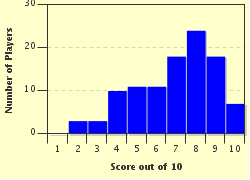Quiz Answer Key and Fun Facts
1. The Cape lion was known for having which exceptionally large attribute?
2. What was the main cause of the extinction of the bubal hartebeest?
3. Who/what were primarily to blame for the rapid population decline of the saddle-backed Rodrigues giant tortoise (Cylindraspis vosmaeri)?
4. The extinct African bird known as the Mauritius blue pigeon was reported to have feasted on which of the following as the main component of their diet?
5. The Cape warthog was named after which of the following African capes?
6. The Western black rhino was declared extinct in 2011.
7. The bluebuck or blue antelope was hunted to extinction for its blue horns.
8. Where have scientists obtained most of their information about the extinct red gazelle?
9. In which part of Africa was the Atlas bear thought to roam?
10. Which one of these 'Q' animals is an extinct species of African zebra?
Source: Author
dcpddc478
This quiz was reviewed by FunTrivia editor
Tizzabelle before going online.
Any errors found in FunTrivia content are routinely corrected through our feedback system.

